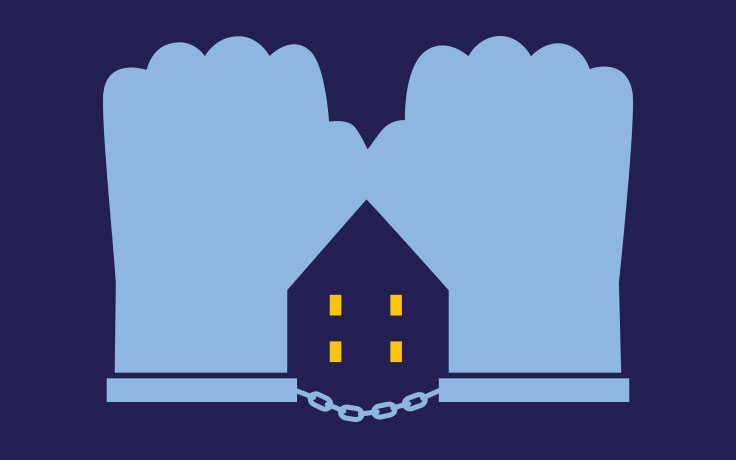Michael Lens is all-too familiar with the struggles of those in subsidized housing.
“Our world discriminates against poor people,” said Lens, an associate professor of urban planning and public policy at UCLA. “When you come in the door with a voucher, you’re labeling yourself as a poor person. Let’s just be real about that.”
For the more than a decade, Lens has been studying job accessibility, housing subsidies, such as government vouchers, and low-income housing. Much of Lens’ work examines whether housing vouchers allow recipients to live in safer neighborhoods and whether voucher holders bring to their neighborhoods an increase in crime. His interest in these living conditions and how people choose where they live led him to look at the relationship between rental housing and crime rates in neighborhoods where vouchers are used.
Lens concentrated much of his work on the federal Housing Choice Voucher program, known as Section 8 or HCV. This program provides rental assistance to more than 5 million people in 2.2 million low-income households nationwide, according to the U.S. Department of Housing and Urban Development, which administers the program through housing authorities across the country.
Created in 1974 as an alternative to government-funded public housing, the voucher program was designed to give low-income individuals and families, the elderly and the disabled a chance to rent privately owned apartments or houses in neighborhoods of their choice. (HUD also has a separate housing choice voucher program for veterans.) Section 8 voucher holders, who generally earn less than 30% to 50% of the area’s median income, pay a portion of their rent, with the government making up the difference. That has spread the poor out of public housing, but it has led some critics to contend that the program has fueled crime in previously safe neighborhoods.
Growing up in Minnesota, Lens saw firsthand the realities of housing assistance programs. “My mom was on Section 8. I grew up in not-so-well-off circumstances,” he said. “I lived in neighborhoods that you would not be particularly fearful of. But as a person of color growing up in a place that was so white, it was sometimes even more obvious that all of the really poor neighborhoods were black and brown, mostly black, at that time.”
Growing up, discovering a calling
Lens was the only child of a single mother in St. Paul, and he was largely oblivious of his circumstances when he was young. “I had a very happy childhood. I didn’t even think about it,” he said. “I didn’t know much until I was talking to my mother about it later. Thinking about neighborhoods in Minneapolis and St. Paul, racial segregation is very visible.”
That was his past. His present is a bright, fifth-floor office on the UCLA campus, his tidy desk adorned with colorful drawings by his children. When he looks up from his computer, he faces a wall with mounted photos of scenes around the Jordan Downs housing project in South Los Angeles, including one depicting young kids playing in a plastic swimming pool in front of a weather-beaten apartment, with bars covering the doors and windows. The 40-year-old married father of two says he recently took a self-guided tour of the Jordan Downs redevelopment project, the biggest public housing redevelopment in LA history.
Despite his upbringing, Lens didn’t develop an interest in urban policy until late in his college career. “I was interested in anything the government does to reduce poverty, to reduce the number of people living in poverty and make living in poverty less of a horrible condition,” he said. That led him to study labor market policy and how to get people jobs or better jobs. By the time he earned his doctorate at NYU, he had married his interest in how to make the lives of the poor better with his research on neighborhoods and segregation and why people live where they live.
“One question I was trying to answer was: Now that more low-income renters are subsidized through the voucher program than public housing, are they living in higher crime environments or lower crime environments than they would be if they were still in public housing?” Lens said. “The answer that I found is there seems to be clearly lower crime.”
The modern-day image of people on government assistance stems largely from the historical view of subsidized housing in America, which has long been synonymous with poverty and high crime. Lens’ research attempts to dispel that mythology.
“We found that the connection people observe between voucher households and crime has more to do with the fact that voucher households have limited options on the housing market, and they are more likely to move to higher crime environments,” he said. “It’s not that they tend to bring crime to neighborhoods.”
Most public housing in the United States was constructed in the ’40s, ’50 and ’60s, often as high-density, high-rise building complexes that replaced shantytowns, tenements and slum areas. Many of these complexes lacked adequate funding and fell into disrepair and decay. Some, such as Cabrini-Green and Robert Taylor Homes in Chicago, Pruitt-Igoe in St. Louis, and Jordan Downs in Los Angeles, did become notorious centers of crime, drugs and gang activity. Critics seized on those numbers and blamed the poor for crime.
The voucher system emerged in the ’70s as an alternative to high-density, high-rise public housing. “We started to look at these [public housing] properties as mistakes, crime infested or dangerous because we had built these in very segregated places and then largely neglected them. The only people who would live there were extremely poor and desperate,” Lens said. “So that’s the kind of stereotypical picture we have of public housing. That’s the vast majority of the experience of public housing in this country.”
The hope was that vouchers would allow users to seek out private landlords in areas dispersed throughout communities, making subsidized housing less centralized and, perhaps, in better neighborhoods. In 1986, the Low-Income Housing Tax Credit program was created to offer incentives to private developers who add low-income housing units to their buildings.
Because Section 8 voucher holders are renting from private landlords, they have more anonymity and the potential to escape the segregation, stratification and stigma that may come from living in public housing complexes. The same is true, for the most part, for tenants of LIHTC buildings. “I couldn’t bring you to 10 properties that were built with low-income housing tax credit funds without talking to a nonprofit developer; they would have to bring me around,” Lens said. “We don’t know what they look like – they look like anybody else’s multi-family property.”
For that reason and others, vouchers became the primary means for obtaining subsidized housing, says Lens, whose research has found that Section 8 voucher holders are less likely to live in very high-crime areas than public housing tenants or even LIHTC tenants. That’s largely because LIHTC and public housing units are fixed locations, often in higher crime neighborhoods, while voucher holders have a wider array of options, including suburban areas with lower crime and poverty rates.
Beyond the housing project
Many housing projects across the country have been demolished and, like Jordan Downs, are being redeveloped into modern low-income housing communities. But the problem of finding housing remains an issue. Millions of people nationwide may qualify for low-income housing, yet cities lack the inventory and funding to accommodate them.
Today in Los Angeles, the housing authority manages more than 50,000 Section 8 vouchers. Long waiting lists for vouchers are common nationwide, with wait times spanning years. Los Angeles is no exception. Last October, the Los Angeles Housing Authority opened its waiting list for the first time since 2004. About 188,000 people applied for 20,000 spots on the waiting list. Even those lucky enough to get waitlisted still may spend years waiting to get to the top of the list.
“There’s not an entitlement to rental assistance in this country, so if you are eligible and you apply, and you’re on a wait list, you’re waiting. There’s not necessarily anything for you,” Lens said. “You might be on a wait list for a couple of years or maybe a few months, depending on where you live. In the meantime, you try to figure out how to find a low-cost living situation.”
According to the LA Housing Authority, the average annual income of a family in public housing is about $20,000. About 66% of voucher holders are employed. By comparison, in order to afford the median home price in Los Angeles, households must make about $112,000 a year, the housing authority reports.
Perhaps the biggest challenge for those who have vouchers is finding a place to live in cities like Los Angeles, which has a vacancy rate of about 4%. In Los Angeles, recipients have six months to find landlords who will accept the vouchers or risk losing the subsidy. More than 1.6 million low-income households in California pay more than half of their income for rent, and those households run a high risk of becoming homeless, according to the Center on Budget and Policy Priorities, a nonpartisan research and policy institute based in Washington, D.C.
It appears unlikely that more funds will be allocated to these subsidies. Earlier this year, HUD proposed legislation that could triple the amount of rent the poorest Section 8 voucher holders would have to pay under the program. It also would impose work requirements for some tenants in public housing to “provide an incentive [for renters] to increase their earnings” and “move more people to self-sufficiency,” HUD Secretary Ben Carson said in April when the plans were unveiled.
“What a lot of U.S. cities and housing scholars are increasingly grappling with is the reality that there’s just not likely to be a lot of increased money for subsidy coming from the federal government, and we’ve been restricting housing in a lot of different ways for quite a long time,” Lens said. “We might be hitting some kind of precipice, at least in some markets, where there is just not enough housing to go around, period. It doesn’t matter what kind.”
What next?
So what can be done? In Lens’ view, we need to pay attention to both the rate and location of building efforts.
“We need to build more housing in more places – especially in high-income neighborhoods – to allow for more housing of more types to be built,” said Lens, who recently has been engaging in research on how zoning restrictions contribute to housing crises in urban areas of the U.S. “We need to build a lot more housing in a lot of places that have been incredibly successful in excluding it.”
People are building housing in Los Angeles, but not nearly enough, he said, and “the problem is that we’ve been building not nearly enough for a long time.”
But it’s not simply a matter of building more housing. “We have to pay some attention to how people can get around without being in their cars all day,” he said. “We’ve got this big, shiny new light rail on the Westside, and the Expo line, and we need a lot more housing along places like that.” The biggest hurdle is NIMBY-ism, with a minority of homeowners pushing their elected officials to keep low-income housing out of their neighborhoods.
A bill introduced by state Sen. Scott Wiener of San Francisco, SB 827, sought to remove control of zoning regulation from local governments, ensuring that all new housing construction within a half-mile of a train station or a quarter-mile of a bus route would not be subject to size, height, number of apartments or restrictive design standards. Though the bill was defeated, Lens called it a bold move that would have removed power from elected officials who may feel beholden to homeowners opposed to such development.
Yet even for those who receive vouchers and move to better neighborhoods, there’s still a downside, Lens said. The voucher may take people out of bad neighborhoods, but it’s not enough to move an adult out of poverty.
“You might physically move away from poverty, but you’re not going to move out of poverty in your own world any faster than if you are hanging out in public housing,” he said. “It’s not helping you get a job. It’s not getting you a car. It’s not changing your life in any more obvious way than it’s going to help you pay the rent.”
Still, change begins with safe and stable living conditions, which can be a way for the next generation to begin to achieve higher status, Lens says. Decent housing cannot ensure prosperity, but the lack of it almost certainly guarantees poverty.

























